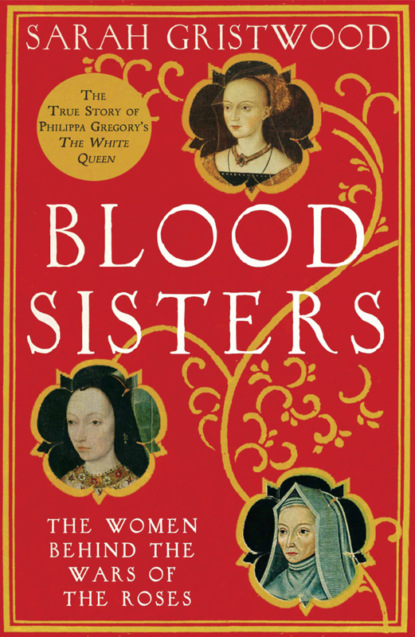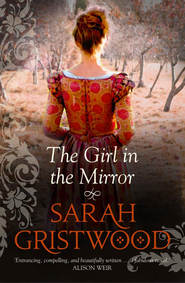По всем вопросам обращайтесь на: info@litportal.ru
(©) 2003-2024.
✖
Blood Sisters: The Hidden Lives of the Women Behind the Wars of the Roses
Настройки чтения
Размер шрифта
Высота строк
Поля
17. Letters to Richmond (#litres_trial_promo)
18. Anne My Wife (#litres_trial_promo)
19. In Bosworth Field (#litres_trial_promo)
PART FIVE: 1485–1509 (#litres_trial_promo)
20. True Succeeders (#litres_trial_promo)
21. Golden Sovereignty (#litres_trial_promo)
22. The Edge of Traitors (#litres_trial_promo)
23. Civil Wounds (#litres_trial_promo)
24. Like a Queen Inter Me (#litres_trial_promo)
25. Our Noble Mother (#litres_trial_promo)
Epilogue (#litres_trial_promo)
Keep Reading (#litres_trial_promo)
Footnotes (#litres_trial_promo)
Notes (#litres_trial_promo)
Picture Section (#litres_trial_promo)
Select Bibliography (#litres_trial_promo)
Index (#litres_trial_promo)
Acknowledgements (#litres_trial_promo)
About the Publisher (#litres_trial_promo)
LIST OF ILLUSTRATIONS
1 (#litres_trial_promo). Marguerite of Anjou with Henry VI and John Talbot in the ‘Shrewsbury Talbot Book of Romances’, c.1445. British Library, Royal 15 E. VI, f.2v (© The British Library Board)
2 (#litres_trial_promo). The stained-glass Royal Window in Canterbury Cathedral (© Crown Copyright. English Heritage)
3 (#litres_trial_promo). Margaret Beaufort by Rowland Lockey, late 16th century (By permission of the Master and Fellows of St John’s College, Cambridge)
4 (#litres_trial_promo). Margaret Beaufort’s emblems (© Neil Holmes/The Bridgeman Art Library)
5 (#litres_trial_promo). Cecily Neville’s father, the Earl of Westmoreland, with the children of his second marriage (Bibliothèque Nationale, Paris/Flammarion/The Bridgeman Art Library)
6 (#litres_trial_promo). Portrait of Elizabeth Woodville from 1463 (© The Print Collector/Corbis)
7 (#litres_trial_promo). Anne Neville depicted in the Rous Roll, 1483–85. British Library Add 48976 (© The British Library Board)
8 (#litres_trial_promo). King Richard III by unknown artist, oil on panel, late 16th century; after unknown artist late 15th century (© National Portrait Gallery, London)
9 (#litres_trial_promo). The risen Christ appearing to Margaret of Burgundy by the Master of Girard de Rousillon, from Le dyalogue de la ducesse de bourgogne a Ihesu Crist by Nicolas Finet, c.1470. British Library Add.7970, f.1v (© The British Library Board)
10 (#litres_trial_promo). Elizabeth of York by unknown artist, oil on panel, late 16th century; after unknown artist c. 1500 (© National Portrait Gallery, London)
11 (#litres_trial_promo). The birth of Caesar from Le fait des Romains, Bruges, 1479. British Library Royal 17 F.ii, f.9 (© The British Library Board)
12 (#litres_trial_promo). The Devonshire Hunting Tapestry – Southern Netherlands (possibly Arras), 1430–40 (© Victoria and Albert Museum, London)
13 (#litres_trial_promo). Procession at the Funeral of Queen Elizabeth, 1502 (© The Trustees of the British Museum)
14 (#litres_trial_promo). The preparations for a tournament. Illustration for René of Anjou’s Livre des Tournois, 1488–89? Bibliothèque nationale de France, Francais 2692, f.62v–f.63 (Bibliothèque nationale de France)
15 (#litres_trial_promo). Margaret of Burgundy’s crown, Aachen Cathedral Treasury (© Domkapitel Aachen (photo: Pit Siebigs))
16 (#litres_trial_promo). Song ‘Zentil madona’: from Chansonnier de Jean de Montchenu, 1475?, Bibliothèque nationale de France, MS Rothschild 2973, f.3v–f.4 (Bibliothèque nationale de France)
17 (#litres_trial_promo). The Tower of London from the Poems of Charles of Orleans, c.1500. British Library, Royal 16 F. II f.73 (© The British Library Board)
18 (#litres_trial_promo). Elizabeth of York’s signature on a page of ‘The Hours of Elizabeth the Queen’, c.1415–20. British Library Add 50001, f.22 (© The British Library Board)
19 (#litres_trial_promo). Wheel of Fortune illumination from the Troy Book, c.1455–1462. British Library Royal 18 D.II, f.30v (© The British Library Board)
MAP
SIMPLIFIED FAMILY TREE
GLOSSARY OF NAMES
ANNE: the name borne by Anne Neville (1456–85); daughter to the Earl of Warwick, wife first to Edward of Lancaster and then to Richard III. Her mother was another Anne, the heiress Anne Beauchamp, Countess of Warwick (1426–90). Anne was also the name given to the Duchess of Exeter (1439–76), eldest daughter of Richard, Duke of York and Cecily Neville and sister to Edward IV and Richard III. Other English noblewomen bearing the name include one of Cecily’s sisters, who became Duchess of Buckingham; one of Edward IV’s daughters; and Anne Mowbray who was married in childhood to Edward’s youngest son.
BEAUFORT: the family name of Margaret Beaufort (1443–1509), mother to Henry VII, and of the Dukes of Somerset, one of whom was Margaret’s father. The Beaufort family also included Cardinal Beaufort, advisor to Henry VI.
BUTLER, ELEANOR (?–1468): born Eleanor Talbot; the woman who was later said to have been secretly married to Edward IV.
CECILY NEVILLE (or Cicely, 1415–95): matriarch of the York dynasty; wife to Richard, Duke of York; mother to Edward IV and Richard III. The name was also shared by Cecily’s granddaughter (Edward IV’s daughter, 1469–1507).
CLARENCE, GEORGE, DUKE OF (1449–78): son to Cecily Neville and Richard Duke of York. The second of their sons to survive into maturity, Clarence was famously executed on the orders of his brother Edward IV.
DORSET, MARQUIS OF (1455–1501): the title bestowed on Thomas Grey, the eldest son of Elizabeth Woodville by her first husband, John Grey.
EDMUND, EARL OF RUTLAND (1443–60): second son to Richard, Duke of York and Cecily Neville, killed young in battle.
EDWARD: this name was borne most importantly by Edward IV (1442–83), eldest son to Richard, Duke of York and Cecily Neville; and by his own eldest son (1470–83?), the elder of the ‘Princes in the Tower’, who would have reigned as Edward V. The name Edward was also bestowed, however, on the eldest sons both of Henry VI (‘Edward of Lancaster’, 1453–71) and of Richard III (‘Edward of Middleham’, 1476?–84). Both were, in their time, also Prince of Wales. The name Edward may have been considered particularly suitable for kings or prospective kings, perhaps because the last undisputed king of England had been the mighty Edward III. Henry VIII, in the next century, would also call his son ‘Edward’.






